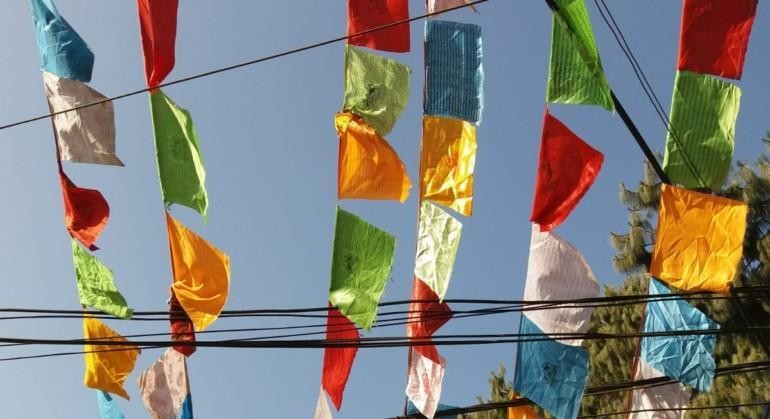Experience of Pilot Realisation of Community Development

I believe every experience is an opportunity to learn something new about yourself. If taken positively, experience is a great teacher that enables every individual to learn, understand and improvise for themselves. Participating in the DVINE Project was a great experience.
The DVINE project has provided a great platform to understand community, community development, dignity, and the use of participatory methods like photo voice, participatory mapping, and the go-along method.
I was involved in study unit 5 – Community Development. This was my first involvement in such a course. It involved teachers from various countries and students from various educational backgrounds. Learning new methods, multi-professional cooperation, developing skills and gaining new friendships were an entirely new experience for me.
Sharing knowledge and experiences
As a microbiology student, I focus mostly on the curriculum related to the microbiology field, but through this course, I have learned about other fields, community development, dignity, and new methods of learning.
Personnel from three different professions, social work, nursing, and microbiology, worked as a team and discussed topics to complete the task. This helped me acknowledge the importance of teamwork and develop an ability to work in a group, as well as to cooperate with the team and gain new friendships.
As people of various educational backgrounds were part of this, we could share our knowledge and ideas, and this allowed us to improve our leadership and communication skills. It also helped broaden our perspectives. One of the best things I experienced through this course was that I was able to work out of my comfort zone, increasing my confidence.
Practising Participatory Methods
The DVINE project gave us an opportunity to learn about community development, applying theoretical knowledge in practice and implementing them in practice by interacting with community people. The practical application of theoretical knowledge helps to give me a clear understanding of the course’s concept.
As part of our fieldwork, we visited ICIMOD (the International Centre for Integrated Mountain Development), St. Xavier’s Social Service Centre and Araniko Secondary School. The main purpose of our visit was to make the participants understand dignity by practising three different participatory methods: photo-voice; participatory mapping; and the go-along method. It was a very motivating and meaningful experience.
Godawari is a beautiful place and famous for its botanical garden, but when we visited ICIMOD, I was awestruck by its beauty and unique concept. It helps promote health, wellbeing and dignity.
ICIMOD is a regional intergovernmental learning and knowledge sharing centre which works especially for the sustainable development of the communities of people of different geographical areas to improve their standard of life and make life easier for them in a very remote and harsh geographical area.
During our visit to ICIMOD, we practised the go-along method. Our guide , who was with us from start to end, was very friendly and informed us about the various activities.
Dignity or no dignity?
Our next visit was to St. Xavier’s Social Service Centre. It is a home away from home for orphans and differently abled children. I must say that the children here were active, talented and inspiring. I learned a lot from them. To gain their trust and get them to participate in our activities, we played with them, shared experiences and stories with each other, and then practised all the participatory methods.
The children were interested in learning about these topics and interacted well with us. They were able to differentiate between dignity and no dignity. The photo-voice method enabled them to express their feelings.
I thought these children would just click on the pictures and simply explain them, but to my surprise, they explained them in greater depth and the story behind it. I can still remember the answers, which were really inspiring.
For participatory mapping, the participating children decided to create a map surrounding the social service centre. Our DVINE team members and children worked together to form a visual representation of a map using locally available resources and pointed out the places which showed dignity and no dignity. Through the go-along method, we got to know about their life, their childhood, where they came from, what their likes and dislikes were, their aim in life and their motivation.
Visiting Araniko Secondary School
For our final visit, we went to Araniko Secondary School, and my team was assigned to the Grade 10 students. As these students were adolescents, we had an informative short session on the topic of adolescence, injury, aggression and violence.
As the DVINE team members came from various educational backgrounds, we decided we wanted to share our knowledge with the students. To do this, all of us (microbiology, nursing, and social work students) also conducted a class where we taught them about blood grouping, some common diseases and food adulteration.
Our main purpose was to give the students an idea of community development and get them to understand dignity and no dignity through photo voice. Students captured meaningful pictures and provided explanations for them.
Students also shared their experiences in this society. They shared what made them feel dignified, and how their dignity was eroded. Although they were shy at first, many students retained their interest and interacted with us. Their involvement helped us achieve our goal of participating community members and practise participatory methods to understand the problems present in our community and the power of community members to solve them. This community development fieldwork allowed me to learn, experience and explore a lot. I will always be grateful for this.
I hope this DVINE project will continue to provide knowledge with pure devotion, spreading positive energy and reaching many people around the world.
Text: Shilpa Shrestha (SXC, Microbiology department)
